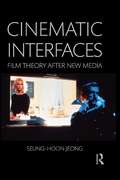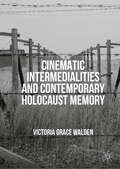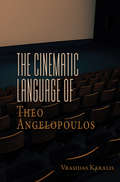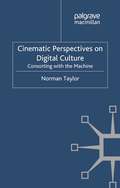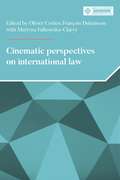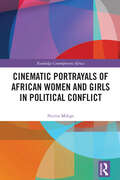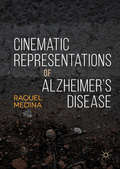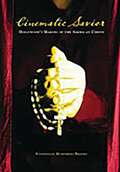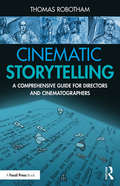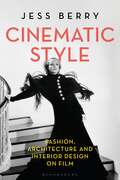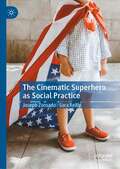- Table View
- List View
Cinematic Homecomings: Exile and Return in Transnational Cinema
by Rebecca PrimeThe history of cinema charts multiple histories of exile. From the German émigrés in 1930s Hollywood to today's Iranian filmmakers in Europe and the United States, these histories continue to exert a profound influence on the evolution of cinematic narratives and aesthetics. But while the effect of exile and diaspora on film practice has been fruitfully explored from both historical and contemporary perspectives, the issues raised by return, whether literal or metaphorical, have yet to be fully considered. Cinematic Homecomings expands upon existing studies of transnational cinema by addressing the questions raised by reverse migration and the return home in a variety of historical and national contexts, from postcolonialism to post-Communism. By looking beyond exile, the contributors offer a multidirectional perspective on the relationship between migration, mobility, and transnational cinema. 'Narratives of return' are among the most popular themes of the contemporary cinema of countries ranging from Morocco to Cuba to the Soviet Union. This speaks to both the sociocultural reality of reverse migration and to its significance on the imagination of the nation.
Cinematic Homecomings: Exile and Return in Transnational Cinema
by Rebecca PrimeThe history of cinema charts multiple histories of exile. From the German émigrés in 1930s Hollywood to today's Iranian filmmakers in Europe and the United States, these histories continue to exert a profound influence on the evolution of cinematic narratives and aesthetics. But while the effect of exile and diaspora on film practice has been fruitfully explored from both historical and contemporary perspectives, the issues raised by return, whether literal or metaphorical, have yet to be fully considered. Cinematic Homecomings expands upon existing studies of transnational cinema by addressing the questions raised by reverse migration and the return home in a variety of historical and national contexts, from postcolonialism to post-Communism. By looking beyond exile, the contributors offer a multidirectional perspective on the relationship between migration, mobility, and transnational cinema. 'Narratives of return' are among the most popular themes of the contemporary cinema of countries ranging from Morocco to Cuba to the Soviet Union. This speaks to both the sociocultural reality of reverse migration and to its significance on the imagination of the nation.
The Cinematic Influence: Interaction and Exchange Between the Cinemas of France and Japan
by Peter C. Pugsley Ben McCannExploring the multiple aesthetic and cultural links between French and Japanese cinema, The Cinematic Influence is packed with vivid examples and case studies of films by Akira Kurosawa, Jean-Luc Godard, Hirokazu Kore-eda, Claire Denis, Naomi Kawase, Michel Gondry and many others. It illustrates the vast array of cinematic connections that mark a long history of mutual influence and reverence between filmmakers in France and Japan. The book provides new insights into the ways that national cinemas resist Hollywood to maintain and strengthen their own cultural practices and how these national cinemas perform the task of informing and enlightening other cultures about what it means to be French or Japanese. This book also deepens our understandings of film's role as a viable cultural and economic player in individual nations. Importantly, the reader will see that film operates as a form of cultural exchange between France and Japan, and more broadly, Europe and Asia. This is the first major book to investigate the crossover between these two diverse national cinemas by tracking their history of shared narrative and stylistic techniques.
The Cinematic Influence: Interaction and Exchange Between the Cinemas of France and Japan
by Peter C. Pugsley Ben McCannExploring the multiple aesthetic and cultural links between French and Japanese cinema, The Cinematic Influence is packed with vivid examples and case studies of films by Akira Kurosawa, Jean-Luc Godard, Hirokazu Kore-eda, Claire Denis, Naomi Kawase, Michel Gondry and many others. It illustrates the vast array of cinematic connections that mark a long history of mutual influence and reverence between filmmakers in France and Japan. The book provides new insights into the ways that national cinemas resist Hollywood to maintain and strengthen their own cultural practices and how these national cinemas perform the task of informing and enlightening other cultures about what it means to be French or Japanese. This book also deepens our understandings of film's role as a viable cultural and economic player in individual nations. Importantly, the reader will see that film operates as a form of cultural exchange between France and Japan, and more broadly, Europe and Asia. This is the first major book to investigate the crossover between these two diverse national cinemas by tracking their history of shared narrative and stylistic techniques.
Cinematic Interfaces: Film Theory After New Media
by Seung-hoon JeongIn this book, Seung-hoon Jeong introduces the cinematic interface as a contact surface that mediates between image and subject, proposing that this mediation be understood not simply as transparent and efficient but rather as asymmetrical, ambivalent, immanent, and multidirectional. Jeong enlists the new media term "interface" to bring to film theory a synthetic notion of interfaciality as underlying the multifaceted nature of both the image and subjectivity. Drawing on a range of films, Jeong examines cinematic interfaces seen on screen and the spectator’s experience of them, including: the direct appearance of a camera/filmstrip/screen, the character’s bodily contact with such a medium-interface, the object’s surface and the subject’s face as "quasi-interface," and the image itself. Each of these case studies serves as a platform for remapping and revamping major concepts in film studies such as suture, embodiment, illusion, signification, and indexicality. Looking to such theories as the ontology of the image and the phenomenology of the body, this original theorization of the cinematic interface not only offers a conceptual framework for rethinking and re-linking film and media studies, but also suggests a general theory of the interface.
Cinematic Interfaces: Film Theory After New Media
by Seung-hoon JeongIn this book, Seung-hoon Jeong introduces the cinematic interface as a contact surface that mediates between image and subject, proposing that this mediation be understood not simply as transparent and efficient but rather as asymmetrical, ambivalent, immanent, and multidirectional. Jeong enlists the new media term "interface" to bring to film theory a synthetic notion of interfaciality as underlying the multifaceted nature of both the image and subjectivity. Drawing on a range of films, Jeong examines cinematic interfaces seen on screen and the spectator’s experience of them, including: the direct appearance of a camera/filmstrip/screen, the character’s bodily contact with such a medium-interface, the object’s surface and the subject’s face as "quasi-interface," and the image itself. Each of these case studies serves as a platform for remapping and revamping major concepts in film studies such as suture, embodiment, illusion, signification, and indexicality. Looking to such theories as the ontology of the image and the phenomenology of the body, this original theorization of the cinematic interface not only offers a conceptual framework for rethinking and re-linking film and media studies, but also suggests a general theory of the interface.
Cinematic Intermedialities and Contemporary Holocaust Memory
by Victoria Grace WaldenThis book explores the growing trend of intermediality in cinematic representations of the Holocaust. It turns to the in-betweens that characterise the cinematic experience to discover how the different elements involved in film and its viewing collaborate to produce Holocaust memory. Cinematic Intermedialities is a work of film-philosophy that places a number of different forms of screen media, such as films that reassemble archive footage, animations, apps and museum installations, in dialogue with the writing of Deleuze and Guattari, art critic-cum-philosopher Georges Didi-Huberman and film phenomenologies. The result is a careful and unique examination of how Holocaust memory can emerge from the relationship between different media, objects and bodies during the film experience. This work challenges the existing concentration on representation in writing about Holocaust films, turning instead to the materials of screen works and the spectatorial experience to highlight the powerful contribution of the cinematic to Holocaust memory.
The Cinematic Language of Theo Angelopoulos
by Vrasidas KaralisBeginning with his first film Reconstruction, released in 1970, Theo Angelopoulos’s notoriously complex cinematic language has long explored Greece’s contemporary history and questioned European culture and society. The Cinematic Language of Theo Angelopoulos offers a detailed study and critical discussion of the acclaimed filmmaker’s cinematic aesthetics as they developed over his career, exploring different styles through which Greek and European history, identity, and loss have been visually articulated throughout his oeuvre, as well as his impact on both European and global cinema.
Cinematic Modernism and Contemporary Film: Aesthetics and Narrative in the International Art Film
by Howard FinnCinema was the most important new artistic medium of the twentieth century and modernism was the most important new aesthetic movement across the arts in the twentieth century. However, what exactly is the relationship between cinema and modernism? Cinematic Modernism and Contemporary Film explores how in the early twentieth century cinema came to be seen as one of the new technologies which epitomised modernity and how cinema itself reflected ideas, hopes and fears concerning modern life. Howard Finn examines the emergence of a new 'international style' of cinema, combining a poetic aesthetic of the image with genre-based fictional narrative and documentary realism. He provides concise accounts of how theorists such as André Bazin, Siegfried Kracauer, Gilles Deleuze and Jacques Rancière have discussed this cinematic aesthetic, clarifying debates over terms such as 'realism', 'classical' and 'avant-garde' as well as recent controversies over terms such as 'slow cinema' and 'vernacular modernism'. He further argues the influence of modernism through close readings of many contemporary films, including films by Abbas Kiarostami, Béla Tarr, Jia Zhangke, and Angela Schanelec.Drawing on a broad range of examples, including Soviet montage, Italian neorealism, postwar new waves and the 'new cinema' of Taiwan and Iran, this book explores the cultural significance of modernism and its lasting influence over cinema.
Cinematic Modernism and Contemporary Film: Aesthetics and Narrative in the International Art Film
by Howard FinnCinema was the most important new artistic medium of the twentieth century and modernism was the most important new aesthetic movement across the arts in the twentieth century. However, what exactly is the relationship between cinema and modernism? Cinematic Modernism and Contemporary Film explores how in the early twentieth century cinema came to be seen as one of the new technologies which epitomised modernity and how cinema itself reflected ideas, hopes and fears concerning modern life. Howard Finn examines the emergence of a new 'international style' of cinema, combining a poetic aesthetic of the image with genre-based fictional narrative and documentary realism. He provides concise accounts of how theorists such as André Bazin, Siegfried Kracauer, Gilles Deleuze and Jacques Rancière have discussed this cinematic aesthetic, clarifying debates over terms such as 'realism', 'classical' and 'avant-garde' as well as recent controversies over terms such as 'slow cinema' and 'vernacular modernism'. He further argues the influence of modernism through close readings of many contemporary films, including films by Abbas Kiarostami, Béla Tarr, Jia Zhangke, and Angela Schanelec.Drawing on a broad range of examples, including Soviet montage, Italian neorealism, postwar new waves and the 'new cinema' of Taiwan and Iran, this book explores the cultural significance of modernism and its lasting influence over cinema.
Cinematic Perspectives on Digital Culture: Consorting with the Machine
by Norman TaylorExploring research into mobile phone use as props to subjective identity, Norman Taylor employs concepts from Michelle Foucault, Gilles Deleuze and actor network theory to discuss the affect of mechanisms of make-believe, from celebrity culture to avatar-obsessed game players, and digital culture.
Cinematic perspectives on international law (Melland Schill Perspectives on International Law)
by Sufyan DroubiThe proposed volume consists of an edited collection within the new Melland Schill Guidebooks on International Law (MSGIL) series. In line with the MSGIL objective of inclusiveness, originality, perspectivism and critical thought, the book is the first of an intended series pertaining to perspectives related to the ways in which the arts influence the perception and attitude of the public towards international law, and the manner this affects the discipline, both in terms of its own development and in terms of its social legitimacy. The book contrasts the narratives of international law depicted in cinema and TV productions with the corresponding narratives advanced by legal scholars. It identifies a cognitive dissonance between them and ascertains its implications on general perceptions of international law.
Cinematic perspectives on international law (Melland Schill Perspectives on International Law)
by Sufyan DroubiThe proposed volume consists of an edited collection within the new Melland Schill Guidebooks on International Law (MSGIL) series. In line with the MSGIL objective of inclusiveness, originality, perspectivism and critical thought, the book is the first of an intended series pertaining to perspectives related to the ways in which the arts influence the perception and attitude of the public towards international law, and the manner this affects the discipline, both in terms of its own development and in terms of its social legitimacy. The book contrasts the narratives of international law depicted in cinema and TV productions with the corresponding narratives advanced by legal scholars. It identifies a cognitive dissonance between them and ascertains its implications on general perceptions of international law.
Cinematic Philosophy
by Tal S. ShamirIn this book, Tal S. Shamir sets out to identify cinema as a novel medium for philosophy and an important way of manifesting and developing philosophical thought. The volume presents a comprehensive analysis of the nature of philosophy’s potential—or, more strongly put, its need—to be manifested cinematically. Drawing on the fields of cinema, philosophy, and media studies, Cinematic Philosophy adds film to the traditional list of ways through which philosophy can be created, concentrating on the unique potential of the cinematic medium to effectively put forward and create philosophy. In the process, the book opens up innovative horizons for new types of knowledge and wisdom grounded in contemporary contexts and philosophical thought. Philosophy, best characterized as the love of wisdom, is not dependent on a specific medium nor solely situated within written text or oral lectures. Shamir asserts that philosophy can, should, and must be manifested and identified in a range of different platforms.
Cinematic Photoreal Environments in Unreal Engine 5: Create captivating worlds and unleash the power of cinematic tools without coding
by Giovanni VisaiGo from learning Unreal Engine 5 fundamentals to achieving stunning photorealistic environments and creating cinematic masterpiecesKey FeaturesImplement advanced shaders, effects, and post-processing to make your environment look cinematicExplore techniques for achieving realistic graphic complexity with incredible performanceCreate your own materials and enhance the visuals of your gaming environmentPurchase of the print or Kindle book includes a free PDF eBookBook DescriptionAs Unreal Engine 5 continues to conquer all industries thanks to its real-time technology, UE skills are becoming more sought after than ever. This three-part book covers all the processes behind the creation of a stunning environment in UE 5. Starting with the steps for installing the game engine and learning about its potential, you’ll quickly progress toward generating a variety of different upwards scaling outputs, each bigger than the previous one. After completing the first part and getting realistic shots of a single object, you’ll delve into the world of landscapes, procedural material and foliage, the Landmass plugin, and water tools by creating an environment using Megascan assets. At this point, you’ll know everything you need to create a fascinating and realistic environment. The final part of this book will teach you how to craft cinematic shots by working with cinematic tools, post processing, and framing tools, and by rendering a photorealistic shot in the last chapter. By the end of this Unreal Engine book, you'll be able to create outstanding and realistic environments using the powerful tools provided by UE as well as have an understanding of the importance of filming and composition in world building.What you will learnGenerate a Master Material to create hundreds of different material instancesExplore lighting principles and apply them to UE lighting systemsEvaluate the pros and cons of real-time rendering in the world-building processBuild massive landscapes with procedural materials, heightmap, landmass, and waterPopulate an environment with realistic assets using Foliage and MegascanMaster the art of crafting stunning shots with SequencerEnhance visual quality with Post Process Volume and NiagaraProduce a photorealistic shot using the Movie Render QueueWho this book is forIf you are a creative director, designer, or creator with a passion for technology and CGI, this UE 5 book is for you. Game developers and tech artists will also benefit from this book as it can help them understand an environment artist’s workflow and how to optimize performance.
Cinematic Portrayals of African Women and Girls in Political Conflict (Routledge Contemporary Africa)
by Norita MdegeThis book provides an interdisciplinary exploration of the cinematic representations of the experiences of African women and girls in situations of political conflict. The role of cinema is important in providing information about the situation of women and girls in situations of political conflict, and the main characters often also become signifiers of wider social, political and economic ideas, at both global and local levels. Drawing on fictional and biographical cinematic representations, this book considers films covering a range of different regions, experiences, historical periods and other contexts, to draw a nuanced picture of African women and girls who participate in or are affected by African political conflicts. The films are analysed using a decolonial feminist cultural approach, which combines cultural approaches, African feminisms and the contrapuntal method to ensure an inter-textual, intersectional and decolonial examination. The book engages with multiple themes and topics, including nationalism, nation-building, neocolonialism, memory, history, women’s and girls’ agency and activism. Through these themes and topics, the book explores how the films represent African women’s and girls’ agency in relation to their participation in social, economic and political activities. This book will make a significant contribution to literature focused on African women and girls within politics, conflict studies and film studies.
Cinematic Portrayals of African Women and Girls in Political Conflict (Routledge Contemporary Africa)
by Norita MdegeThis book provides an interdisciplinary exploration of the cinematic representations of the experiences of African women and girls in situations of political conflict. The role of cinema is important in providing information about the situation of women and girls in situations of political conflict, and the main characters often also become signifiers of wider social, political and economic ideas, at both global and local levels. Drawing on fictional and biographical cinematic representations, this book considers films covering a range of different regions, experiences, historical periods and other contexts, to draw a nuanced picture of African women and girls who participate in or are affected by African political conflicts. The films are analysed using a decolonial feminist cultural approach, which combines cultural approaches, African feminisms and the contrapuntal method to ensure an inter-textual, intersectional and decolonial examination. The book engages with multiple themes and topics, including nationalism, nation-building, neocolonialism, memory, history, women’s and girls’ agency and activism. Through these themes and topics, the book explores how the films represent African women’s and girls’ agency in relation to their participation in social, economic and political activities. This book will make a significant contribution to literature focused on African women and girls within politics, conflict studies and film studies.
Cinematic Representations of Alzheimer’s Disease
by Raquel MedinaThis book offers a cross-cultural approach to cinematic representations of Alzheimer’s disease in non-mainstream cinema. Even though Alzheimer’s disease, the most common form of dementia, is a global health issue, it is not perceived or represented homogenously around the world. Contrary to very well-known mainstream films, the films discussed do not focus on the negative aspects normally associated with Alzheimer’s disease, but on the importance of portraying the perspective of the persons living with Alzheimer’s and their personhood. Similarly, this book analyses how the films use Alzheimer’s as a trope to address issues relating to different areas of life and society such as, for example, family matters, intergenerational relationships, gender issues, national traditions versus global modernity, and caring for people with dementia. By examining an array of films, from crime fiction to documentary, that each present non-stigmatising representations of Alzheimer’s disease, this in-depth study ultimately demonstrates the power of culture in shaping meaning.
Cinematic Savior: Hollywood's Making of the American Christ
by Stephenson Humphries-BrooksFrom Cecil B. DeMille's production of King of Kings in 1927, to Mel Gibson's recent The Passion of the Christ, films that discuss the meaning of Jesus have provoked interest, discussion, and reevaluation on a large scale. Hollywood films that deal with this subject have consistently managed to augment their inherent power by commenting simultaneously on political and cultural matters, and drawing from alternative cultural and mythological sources. The Greatest Story Ever Told, for instance, uses a landscape similar to that of the American West, while The Last Temptation of Christ deals with themes related to modern American notions of sexuality and sin. This timely examination considers the life of Jesus as it has been portrayed in such films as King of Kings, The Greatest Story Ever Told, Jesus of Nazareth, The Last Temptation of Christ, and The Passion of the Christ, as well as the more allusive and implicit use of Christ-related themes in Spartacus, Shane, and The Matrix. It looks at the diverse content and often-surprising impact of these and other films, and reveals how these depictions have helped determine, and been determined by, particularly American notions of who Jesus was, how he lived and died, and what he means for both our religious and secular cultures.Through an objective consideration of these movies, the emergent religious culture of mainstream American film becomes apparent as a central element in Hollywood movies—and in American popular culture at large.
Cinematic Storytelling: A Comprehensive Guide for Directors and Cinematographers
by Thomas RobothamThis book presents a new, story-based approach to cinematic coverage and storytelling in film and video. It breaks from the conventional idea that shots are the fundamental unit of filmmaking, instead exploring the specifics of determining coverage. Keyframes in patterns are introduced, delivering scripted material in a context-rich presentation that supports the storytelling. All the analysis, interpretation, and creative decision making is done first, with shots derived as the very last step. Scripted material is divided into six categories with associated patterns. Like cinematic building blocks, these can freely stack up and interconnect, supporting creativity and avoiding rigid formulas. This approach enables filmmakers to tap into the film "language" that audiences already understand and put it to practical use, helping the audience to feel the storytelling deeply. Dozens of film examples are provided throughout, plus conceptual and camera diagrams to contextualize the methods presented, and exercises are provided to reinforce concepts. Emphasis is placed on supporting performance and story meaning through a cinematic context. With all the concepts and decision-making options described and shown in examples, a scripted scene is analyzed and developed through an eight-step process, illustrated with storyboard, camera diagrams, and ultimately shot list descriptions. The book is ideal for filmmaking students interested in directing and cinematography, as well as aspiring and early-career filmmakers, cinematographers, and directors.
Cinematic Storytelling: A Comprehensive Guide for Directors and Cinematographers
by Thomas RobothamThis book presents a new, story-based approach to cinematic coverage and storytelling in film and video. It breaks from the conventional idea that shots are the fundamental unit of filmmaking, instead exploring the specifics of determining coverage. Keyframes in patterns are introduced, delivering scripted material in a context-rich presentation that supports the storytelling. All the analysis, interpretation, and creative decision making is done first, with shots derived as the very last step. Scripted material is divided into six categories with associated patterns. Like cinematic building blocks, these can freely stack up and interconnect, supporting creativity and avoiding rigid formulas. This approach enables filmmakers to tap into the film "language" that audiences already understand and put it to practical use, helping the audience to feel the storytelling deeply. Dozens of film examples are provided throughout, plus conceptual and camera diagrams to contextualize the methods presented, and exercises are provided to reinforce concepts. Emphasis is placed on supporting performance and story meaning through a cinematic context. With all the concepts and decision-making options described and shown in examples, a scripted scene is analyzed and developed through an eight-step process, illustrated with storyboard, camera diagrams, and ultimately shot list descriptions. The book is ideal for filmmaking students interested in directing and cinematography, as well as aspiring and early-career filmmakers, cinematographers, and directors.
Cinematic Style: Fashion, Architecture and Interior Design on Film
by Jess BerryFrom cinema's silent beginnings, fashion and interior design have been vital to character development and narrative structure. Despite spectacular technological advancements on screen, stunning silhouettes and striking spaces still have the ability to dazzle to dramatic effect. This book is the first to consider the significant interplay between fashion and interiors and their combined contribution to cinematic style from early film to the digital age.With examples from Frank Lloyd Wright inspired architecture in Hitchcock's North by Northwest, to Coco Chanel's costumes for Gloria Swanson and a Great Gatsby film-set turned Ralph Lauren flagship, Cinematic Style describes the reciprocal relationship between these cultural forms. Exposing the bleeding lines between fashion and interiors in cinematic and real-life contexts, Berry presents case studies of cinematic styles adopted as brand identities and design movements promoted through filmic fantasy.Shedding light on consumer culture, social history and gender politics as well as on fashion, film and interior design theory, Cinematic Style considers the leading roles domestic spaces, quaint cafes, little black dresses and sharp suits have played in 20th and 21st-century film.
Cinematic Style: Fashion, Architecture and Interior Design on Film
by Jess BerryFrom cinema's silent beginnings, fashion and interior design have been vital to character development and narrative structure. Despite spectacular technological advancements on screen, stunning silhouettes and striking spaces still have the ability to dazzle to dramatic effect. This book is the first to consider the significant interplay between fashion and interiors and their combined contribution to cinematic style from early film to the digital age.With examples from Frank Lloyd Wright inspired architecture in Hitchcock's North by Northwest, to Coco Chanel's costumes for Gloria Swanson and a Great Gatsby film-set turned Ralph Lauren flagship, Cinematic Style describes the reciprocal relationship between these cultural forms. Exposing the bleeding lines between fashion and interiors in cinematic and real-life contexts, Berry presents case studies of cinematic styles adopted as brand identities and design movements promoted through filmic fantasy.Shedding light on consumer culture, social history and gender politics as well as on fashion, film and interior design theory, Cinematic Style considers the leading roles domestic spaces, quaint cafes, little black dresses and sharp suits have played in 20th and 21st-century film.
The Cinematic Superhero as Social Practice
by Joseph Zornado Sara ReillyThis book analyzes the cinematic superhero as social practice. The study’s critical context brings together psychoanalysis and restorative and reflective nostalgia as a way of understanding the ideological function of superhero fantasy. It explores the origins of cinematic superhero fantasy from antecedents in myth and religion, to twentieth-century comic book, to the cinematic breakthrough with Superman (1978). The authors then focus on Spider-Man as reflective response to Superman’s restorative nostalgia, and read MCU’s overarching narrative from Iron Man to End Game in terms of the concurrent social, political, and environmental conditions as a world in crisis. Zornado and Reilly take up Wonder Woman and Black Panther as self-conscious attempts to reflect on gender and race in restorative superhero fantasy, and explore Christopher Nolan’s Dark Knight trilogy as a meditation on the need for authoritarian fascism. The book concludes with Logan, Wonder Woman 1984, and Amazon Prime’s The Boys as distinctly reflective fantasy narratives critical of the superhero fantasy phenomenon.
Cinematic Terror: A Global History of Terrorism on Film
by Tony ShawCinematic Terror takes a uniquely long view of filmmakers' depiction of terrorism, examining how cinema has been a site of intense conflict between paramilitaries, state authorities and censors for well over a century. In the process, it takes us on a journey from the first Age of Terror that helped trigger World War One to the Global War on Terror that divides countries and families today. Tony Shaw looks beyond Hollywood to pinpoint important trends in the ways that film industries across Europe, North and South America, Asia, Africa and the Middle East have defined terrorism down the decades. Drawing on a vast array of studio archives, government documentation, personal interviews and box office records, Shaw examines the mechanics of cinematic terrorism and challenges assumptions about the links between political violence and propaganda.



